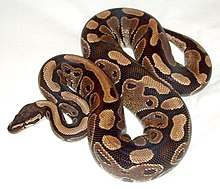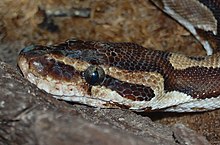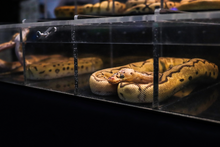Ball python
| Ball python | |
|---|---|

| |
| Scientific classification | |
| Domain: | Eukaryota |
| Kingdom: | Animalia |
| Phylum: | Chordata |
| Class: | Reptilia |
| Order: | Squamata |
| Suborder: | Serpentes |
| Family: | Pythonidae |
| Genus: | Python |
| Species: | P. regius
|
| Binomial name | |
| Python regius (Shaw,1802)
| |

| |
| Distribution map of ball python | |
| Synonyms | |
Theball python(Python regius), also called theroyal python,is apythonspecies native toWestandCentral Africa,where it lives ingrasslands,shrublands and open forests. Thisnonvenomousconstrictoris the smallest of the African pythons, growing to a maximum length of 182 cm (72 in).[2]The name "ball python" refers to its tendency to curl into a ball whenstressedor frightened.[3]
Taxonomy
[edit]Boa regiawas thescientific nameproposed byGeorge Shawin 1802 for a pale variegated python from an indistinct place in Africa.[4] ThegenericnamePythonwas proposed byFrançois Marie Daudinin 1803 for non-venomous flecked snakes.[5]Between 1830 and 1849, several generic names were proposed for the samezoological specimendescribed by Shaw, includingEnygrusbyJohann Georg Wagler,CenchrisandHertuliabyJohn Edward Gray.Gray also described four specimens that were collected in Gambia and were preserved in spirits and fluid.[6]
Description
[edit]
The ball python is black, or albino and dark brown with light brown blotches on the back and sides. Its white or cream belly is scattered with black markings. It is a stocky snake with a relatively small head and smooth scales.[3]It reaches a maximum adult length of 182 cm (6 ft 0 in). Males typically measure eight to tensubcaudal scales,and females typically measure two to four subcaudal scales.[7]Females reach an average snout-to-vent length of116.2 cm (45+3⁄4in), a44.3 mm (1+3⁄4in) long jaw, an8.7 cm (3+7⁄16in) long tail and a maximum weight of 1.635 kg (3 lb 9.7 oz). Males are smaller with an average snout-to-vent length of111.3 cm (43+13⁄16in), a43.6 mm (1+23⁄32in) long jaw, an8.6 cm (3+3⁄8in) long tail and a maximum weight of 1.561 kg (3 lb 7.1 oz).[8] Both sexes havepelvic spurson both sides of the vent. Duringcopulation,males use these spurs for gripping females.[9]Males tend to have larger spurs, and sex is best determined by manual eversion of the malehemipenesor inserting a probe into thecloacato check the presence of an inverted hemipenis.[10]
Distribution and habitat
[edit]The ball python is native to westSub Saharan AfricafromSenegalthroughCameroontoSudanandUganda.[1] It prefers grasslands,savannas,and sparsely wooded areas.[3]
Behavior and ecology
[edit]Ball pythons are typically nocturnal or crepuscular, meaning that they are active during dusk, dawn, and/or nighttime.[11]This species is known for its defense strategy that involves coiling into a tight ball when threatened, with its head and neck tucked away in the middle. This defense behavior is typically employed in lieu of biting, which makes this species easy for humans to handle and has contributed to their popularity as a pet.[3]
In the wild, ball pythons favor mammal burrows and other underground hiding places, where they alsoaestivate.Males tend to display more semi-arboreal behaviors, whilst females tend towards terrestrial behaviors.[11]
Diet
[edit]The diet of the ball python in the wild consists mostly of small mammals and birds. Young ball pythons of less than 70 cm (28 in) prey foremost on small birds. Ball pythons longer than 100 cm (39 in) prey foremost on small mammals. Males prey more frequently on birds, and females more frequently on mammals.[11]Rodents make up a large percentage of the diet;Gambian pouched rats,black rats,rufous-nosed rats,shaggy rats,andstriped grass miceare among the species consumed.[12]
Reproduction
[edit]
Females areoviparousand lay three to 11 rather large, leathery eggs.[7]The eggs hatch after 55 to 60 days. Young male pythons reach sexual maturity at 11–18 months, and females at 20–36 months. Age is only one factor in determining sexual maturity and the ability to breed; weight is the second factor. Males breed at 600 g (21 oz) or more, but in captivity are often not bred until they are 800 g (28 oz), although in captivity, some males have been known to begin breeding at 300–400 g (11–14 oz). Females breed in the wild at weights as low as 800 g (28 oz) though 1,200 g (42 oz) or more in weight is most common; in captivity, breeders generally wait until they are no less than 1,500 g (53 oz). Parental care of the eggs ends once they hatch, and the female leaves the offspring to fend for themselves.[10]
Parthenogenetic reproductionwas demonstrated in a pet ball python.[13]A genetic comparison of a mother and her early-stage embryos demonstrated the parthenogenetic origin of the latter.[13]
Threats
[edit]The ball python is listed asNear Threatenedon theIUCN Red List;it experiences a high level of exploitation and the population is believed to be in decline in most of West Africa.[1]The ball python is primarily threatened bypoachingfor the international exoticpet trade.It is also hunted for its skin, meat and use intraditional medicine.Other threats include habitat loss as a result of intensified agriculture and pesticide use.[1]Rural hunters in Togo collect gravid females and egg clutches, which they sell to snake ranches. In 2019 alone, 58 interviewed hunters had collected 3,000 live ball pythons and 5,000 eggs.[14]
In captivity
[edit]

Ball pythons are the most popular pet snake and the second most popular pet reptile after the bearded dragon.[15]According to the IUCN Red List, while captive bred animals are widely available in the pet trade, capture of wild specimens for sale continues to cause significant damage to wild populations.[1]Wild-caught specimens have greater difficulty adapting to a captive environment, which can result in refusal to feed, and they generally carry internal or externalparasites.[citation needed]This species can do quite well in captivity, regularly living for 15–30 years with good care. The oldest recorded ball python in captivity is 62 years, 59 of those at theSaint Louis Zoo.[16]
Breeding
[edit]
Captive ball pythons are often bred for specific patterns that do not occur in the wild, called "morphs."[17][18]Breeders are continuously creating new designer morphs, and over 7,500 different morphs currently exist.[18][19][20]Most morphs are considered solely cosmetic with no harm or benefit to the individual animal. However, the "spider" morph gene has been linked to neurological disease, typically involving symptoms such as head tremors and lack of coordination that are collectively referred to as "wobble syndrome."[21]Due to the ethical concerns associated with intentionally breeding a color pattern linked to genetic disease, the International Herpetological Society banned the sale of spider morphs at their events beginning in 2018.[22]
In culture
[edit]The ball python is particularly revered by theIgbo peoplein southeasternNigeria,who consider it symbolic of the earth, being an animal that travels so close to the ground. Even Christian Igbos treat ball pythons with great care whenever they come across one in a village or on someone's property; they either let them roam or pick them up gently and return them to a forest or field away from houses. If one is accidentally killed, many communities on Igbo land still build a coffin for the snake's remains and give it a short funeral.[23][24][25]In northwesternGhana,there is a taboo towards pythons as people consider them a savior and cannot hurt or eat them. According to folklore a python once helped them flee from their enemies by transforming into a log to allow them to cross a river.[26]
References
[edit]- ^abcdeD'Cruze, N.; Wilms, T.; Penner, J.; Luiselli, L.; Jallow, M.; Segniagbeto, G.; Niagate, B.; Schmitz, A. (2021)."Python regius".IUCN Red List of Threatened Species.2021:e.T177562A15340592.doi:10.2305/IUCN.UK.2021-2.RLTS.T177562A15340592.en.Retrieved11 November2023.
- ^abMcDiarmid, R. W.; Campbell, J. A.; Touré, T. (1999).Snake Species of the World: A Taxonomic and Geographic Reference.Vol. 1. Washington, DC: Herpetologists' League.ISBN1-893777-00-6.
- ^abcdMehrtens, J. M. (1987)."Ball Python, Royal Python (Python regius) ".Living Snakes of the World in Color.New York: Sterling Publishers. p. 62.ISBN080696460X.
- ^Shaw, G. (1802)."Royal Boa".General zoology, or Systematic natural history. Volume III, Part II.London: G. Kearsley. pp. 347–348.
- ^Daudin, F. M. (1803)."Python".Histoire naturelle, générale et particulière, des reptiles.Vol. Tome 8. Paris: De l'Imprimerie de F. Dufart. p. 384.
- ^Gray, J. E. (1849)."The Royal Rock Snake".Catalogue of the specimens of snakes in the collection of the British museum.London: The Trustees. pp. 90–91.
- ^abBarker, D. G.; Barker, T. M. (2006).Ball Pythons: The History, Natural History, Care and Breeding.Pythons of the World. Vol. 2. Boerne, TX: VPI Library.ISBN0-9785411-0-3.
- ^Aubret, F.; Bonnet, X.; Harris, M.; Maumelat, S. (2005). "Sex Differences in Body Size and Ectoparasite Load in the Ball Python,Python regius".Journal of Herpetology.39(2): 315–320.doi:10.1670/111-02N.JSTOR4092910.S2CID86230972.
- ^Rizzo, J. M. (2014). "Captive care and husbandry of ball pythons (Python regius) ".Journal of Herpetological Medicine and Surgery.24(1): 48–52.doi:10.5818/1529-9651-24.1.48.S2CID162806864.
- ^abMcCurley, K. (2005).The Complete Ball Python: A Comprehensive Guide to Care, Breeding and Genetic Mutations.ECO & Serpent's Tale Natural History Books.ISBN978-097-131-9.
- ^abcLuiselli, L. & Angelici, F. M. (1998). "Sexual size dimorphism and natural history traits are correlated with intersexual dietary divergence in royal pythons (Python regius) from the rainforests of southeastern Nigeria ".Italian Journal of Zoology.65(2): 183–185.doi:10.1080/11250009809386744.
- ^"Python regius(Ball Python, Royal Python) ".Animal Diversity Web.
- ^abDi Ianni F, Albarella S, Vetere A, Torcello M, Ablondi M, Pugliano M, Di Mauro S, Parma P, Ciotola F (August 2023)."Demonstration of Parthenogenetic Reproduction in a Pet Ball Python (Python regius) through Analysis of Early-Stage Embryos".Genes (Basel).14(9): 1744.doi:10.3390/genes14091744.PMC10531270.PMID37761884.
- ^D’Cruze, N.; Harrington, L.A.; Assou, D.; Ronfot, De.; Macdonald, D.W.; Segniagbeto, G.H.; Auliya, M. (2020)."Searching for snakes: ball python hunting in southern Togo, West Africa".Nature Conservation.38:13–36.doi:10.3897/natureconservation.38.47864.
- ^Valdez, Jose W. (3 March 2021)."Using Google Trends to Determine Current, Past, and Future Trends in the Reptile Pet Trade".Animals.11(3): 676.doi:10.3390/ani11030676.PMC8001315.PMID33802560.
- ^"A new squeeze? Snake mystery after lone, elderly python lays a clutch of eggs".TheGuardian.com.2020.Retrieved11 September2020.
- ^Bulinski, S. C. (2016)."A Crash Course in Ball Python/Reptile Genetics".Reptiles magazine.
- ^abGiggs, Rebecca (21 February 2024)."Skin in the Game".The New Yorker.Retrieved19 February2024.
- ^"Morph List – World of Ball Pythons".World of Ball Pythons.Retrieved31 August2021.
- ^Yurdakul E. (2020)."Ball Python Morphs".Reptilian world.
- ^Rose, M. P. & Williams, D. L. (2014). "Neurologic dysfunction in a ball python (Python regius) color morph, and implications for welfare ".Journal of Exotic Pet Medicine.23(3): 234–239.doi:10.1053/j.jepm.2014.06.002.
{{cite journal}}:CS1 maint: multiple names: authors list (link) - ^"Breeders Meetings – New Policy – June 2017".International Herpetological Society. 2017. Archived fromthe originalon 8 May 2020.
- ^Hambly, Wilfrid D. (1931)."Serpent worship in Africa".Fieldiana Anthropology.Publication. Field Museum of Natural History.21(1): 1–85.doi:10.5962/bhl.title.7137.hdl:10111/UIUCOCA:serpentworshipin211hamb.JSTOR29782194.OCLC678589753.[obsolete source]
- ^Udengwu, Ngozi; Erojikwe, Ikechukwu; Nnanna, Ndubuisi (2019)."Cultural transformation and the trials of the sacred python in text and context".Creative Artist: A Journal of Theatre and Media Studies.13(2): 22–49.
- ^Drewal, Henry John (1988). "Interpretation, Invention, and Re-Presentation in the Worship of Mami Wata".Journal of Folklore Research.25(1/2): 101–139.JSTOR3814277.
- ^Diawuo, Francis; Issifu, Abdul Karim (December 2015)."Exploring the African traditional belief systems in natural resource conservation and management in Ghana"(PDF).Journal of Pan African Studies.8(9): 115–132.S2CID146125167.GaleA441766901.
External links
[edit]- "Python regius".Integrated Taxonomic Information System.Retrieved12 September2007.
- Python regiusat theReptarium.cz Reptile Database.Accessed 12 September 2007.
- Krishnasamy, Vikram; Stevenson, Lauren; Koski, Lia; Kellis, Marilee; Schroeder, Betsy; Sundararajan, Madhura; Ladd-Wilson, Stephen; Sampsel, Ashley; Mannell, Mike; Classon, Andrew; Wagner, Darlene; Hise, Kelley; Carleton, Heather; Trees, Eija; Schlater, Linda; Lantz, Kristina; Nichols, Megin (19 May 2018)."Notes from the Field: Investigation of an Outbreak of Salmonella Paratyphi B Variant L(+) tartrate + (Java) Associated with Ball Python Exposure — United States, 2017".MMWR. Morbidity and Mortality Weekly Report.67(19): 562–563.doi:10.15585/mmwr.mm6719a7.PMC6048943.PMID29771878.
- IUCN Red List near threatened species
- Python (genus)
- Snakes of Africa
- Fauna of Sub-Saharan Africa
- Reptiles of West Africa
- Reptiles of Cameroon
- Reptiles of the Central African Republic
- Reptiles of the Democratic Republic of the Congo
- Reptiles of South Sudan
- Reptiles of Uganda
- Reptiles described in 1802
- Taxa named by George Shaw
- Reptiles as pets

